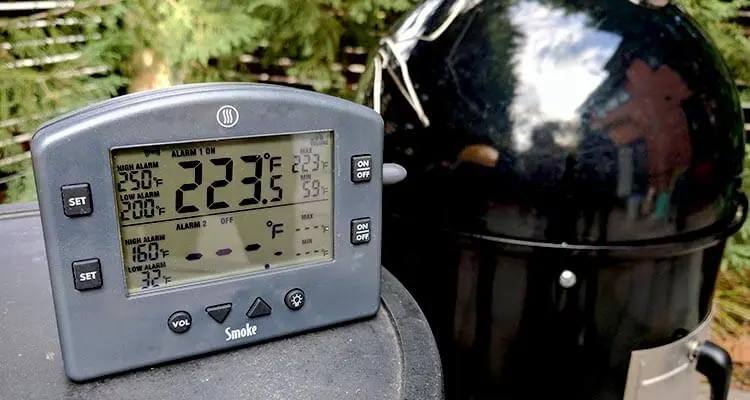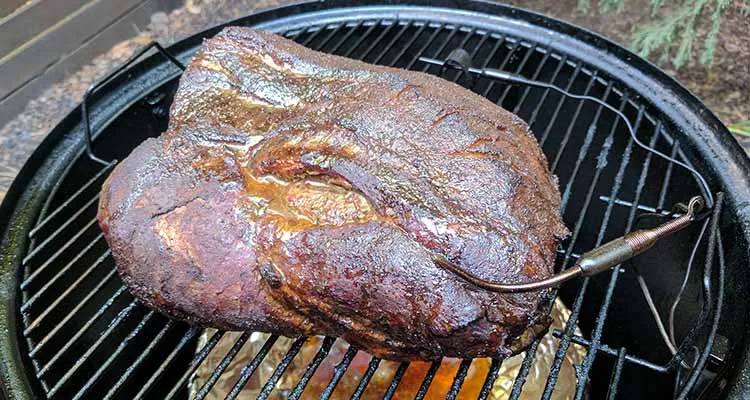The first step on your journey to becoming a master of the pit is knowing exactly what temperature to smoke at, and when to pull your food.
What you can’t tell from watching shows like BBQ Pit Masters, is that even the experts use a good digital meat thermometer to measure the temperature in their smoker, and to know exactly when the meat is at its most tender.
Whether you’re smoking beef brisket, pork butt, fish or sausage, use this chart to know what temperature to smoke at and at what temp your food is cooked at.
We’ve also included an approximate cooking time, but you should always use temperature to determine when the meat is done cooking.
Free Chart: Download a free copy of our smoking times and temperatures chart so you can refer back to it whenever you need.
Beef smoking times and temperatures
| Smoker Temp | Finished Temp | Smoking Time | |
|---|---|---|---|
| Beef brisket | 225-250° F | 190-205°F | 12 - 20 hours |
| Back ribs | 225-250° F | 185-190°F | 3 - 4 hours |
| Short ribs | 225-250° F | 190-200°F | 6 - 8 hours |
| Spare ribs | 225-250° F | 190 to 203°F | 5 - 6 hours |
| Prime rib | 225-250° F | 135° F for Medium | 15 minutes/lb |
| Chuck roast | 225-250° F | 190-200°F | 12 - 20 hours |
| Rump roast | 225-250° F | 145° F for Well Done | 30 minutes/lb |
| Whole ribeye | 225-250° F | 135° F for Medium | 25 minutes/lb |
| Tenderloin | 225-250° F | 130°-140° F | 2 1/2 to 3 hours |
| Tri-tip | 225-250° F | 130° F to 140° F | 2 to 3 hours |
| Sausage | 225-250° F | 160° F | 30 - 60 mins |
How to tell when smoked brisket is done
The ideal temperature for smoked brisket is usually between 195-205°F with many pitmasters aiming to pull right on the 203°F mark.
You need to remember that brisket will continue to cook while you rest it can increase by 10°F or more.
If you’re not sure if your brisket is cooked some good signs include:
- The whole muscle jiggles like a bowl of jello
- You probe it with a toothpick and the probe slides in like it was warm butter.
Beef smoking time notes
- When cooking a Prime rib you can pull off the smoker and finish with a quick stint on the grill or a hot oven to brown the exterior
- For fresh sausages without cure added you need to cook them at hotter temperatures than sausages with the proper amount of cure
Pork smoking times and temperatures
| Smoker Temp | Finished Temp | Smoking Time | |
|---|---|---|---|
| Pork butt | 225-250° F | 205°F | 1.5 hours/lb |
| Baby back ribs | 225-250° F | 180°F | 5 hours |
| Spare ribs | 225-250° F | 180-185°F | 5 - 7 hours |
| Loin | 225-250° F | 145°F | 4 - 5 hours |
| Belly Bacon | less than 100° F | 140° F | 6 hours |
| Whole Hog | 225-250° F | 205° F | 16 - 18 hours |
| Tenderloin | 225-250° F | 160° F | 2 1/2 - 3 hours |
| Pork sausage | 225-250° F | 165° F | 1 to 3 hours |
How to tell when smoked pork butt is done?
You should cook pork butt until it reaches an internal temperature of at least 195°F although lots of people prefer to cook it until it reaches 203°F.
- A typical estimate for pork butt cooking time is 2 hours per pound of pork
- An 8lb pork butt can take up to 16 hours from start to finish
How to tell if your ribs are done?
Ribs are safe to eat at 145°F but they aren’t usually considered done around 190-203°F when the fat and collagen have had a chance to melt and become tender.
- Allow 4-5 hours for a full slab of baby back ribs and 6-7 hours for a slab of spare ribs.
- Properly cooked ribs shouldn’t fall off the bone.
- The best test for a well-cooked slab of ribs is that it starts to crack on the surface when you gentle bounce it with a pair of BBQ tongs.
- When ribs are done the meat will start to pull cleanly back from the bones.
Lamb smoking times and temperatures
| Smoker Temp | Finished Temp | Smoking Time | |
|---|---|---|---|
| Lamb leg | 225-250° F | 140°-150° F | 4 - 8 hours |
| Lamb shank | 225-250° F | 190° F | 4 - 5 hours |
| Lamb shoulder | 225-250° F | 170° F | 5 - 5 1/2 hours |
| Lamb rack | 200-225° F | 135°-140° F | 1 1/4 hours |
Poultry smoking times and temperatures
| Smoker Temp | Finished Temp | Smoking Time | |
|---|---|---|---|
| Chicken whole | 275°-350° F | 170° F | 2 - 3 hours |
| Chicken quarters | 275°-350° F | 170° F | 1 - 2 hours |
| Chicken thighs | 275°-350° F | 170° F | 1 1/2 hours |
| Chicken wings | 275°-350° F | 170° F | 1 1/4 hours |
| Turkey whole | 275°-350° F | 170° F | 4 - 5 hours |
| Turkey leg | 275°-350° F | 170° F | 2 to 3 hours |
| Turkey wings | 275°-350° F | 170° F | 2 - 2 1/2 hours |
| Turkey breast | 275°-350° F | 165° F | 4 hours |
| Quail / Pheasant | 225°F | 165°F | 1 hour |
| Cornish Hens | 240°F | 165°F | 2 hours |
| Whole duck | 225°-250° F | 165°F | 4 hours |
Notes:
- For a whole smoked turkey try and stick to a 10 – 14 pound bird. Larger than this and the meat may stay in the danger zone for too long
Fish and seafood smoking times and temperatures
| Smoker Temp | Finished Temp | Smoking Time | |
|---|---|---|---|
| Salmon whole | 200° F | 145° F | Starts to flake |
| Whole trout | 225°F | 145°F | 1 hour |
| Salmon Filet | 220°F | 145°F | 1 hour |
| Tilapia Filet | 220°F | 145°F | 1 hour |
| Lobster Tails | 225°F | 140°F | 45 min |
| Oysters | 225°F | N/A | 30 - 40 min |
| Scallops | 225°F | 145°F | 45 - 60 min |
| Shrimp | 225°F | N/A | 20 - 30 min |
The problem with relying on temperature charts
Temperature charts are a great guide. It’s especially helpful as a relative newbie to be able to quickly check the time, temperature and average cooking time in one easy place.
But an experienced pitmaster will take issue with any temperature chart.
The fact is, you can produce excellent barbecue cooking low and slow at 225°F or hot and fast 350°F+.
There is also no exact temperature when determining when a brisket or pork butt is perfect. The right temperature to pull your meat can vary by +/- 10-20 degrees.
It’s also difficult to give accurate cooking time estimates. The shape, thickness and diameter of the meat can all be as important as the weight.
This means minutes or hours per lbs calculations are always just an estimate.
All of the following factors can impact smoking time:
- Are you cooking bone-in or deboned meat?
- The thickness and diameter (rather than overall weight) of the meat
- How much connective tissue and fat there is.
- How well insulated your smoker is and the weather will play a factor in the time it takes (Allow longer if you are cooking in the snow).
- Humidity in the smoker and extreme weather can also slow down cooking time.
- Type of smoker can also affect things. According to amazingribs.com If you cook using an electric smoker your meat can be done faster because there is less airflow.
For more on this topic, we have a whole guide to the main 8 factors the influence cooking time.
We have mostly stuck with the ‘low and slow’ smoker temperatures and times in this guide. While it’s a good starting point, you can definitely adjust them.
For example smoked lamb can be smoked hot and fast at 300-350° F for a shorter time period and come out with a better crust.
So long as you cook your meat to the desired safe (and delicious) temperature, and you keep your temperature steady you’re going to have a successful barbecue.
This is why we always recommend using a dual probe thermometer setup like the ThermoWorks Smoke.
Meat temperature health and safety
Because smoking uses much lower temperatures than other methods of cooking, it’s important to follow a few guidelines.
You don’t want to be responsible for poisoning your barbecue guests (except maybe you’re annoying neighbor…).
Welcome to the (meat smoking) danger zone

When meat lingers at temperatures between 40 and 140° F harmful bacteria can quickly multiply. You have about 4 hours tops before things get dangerous.
This is cumulative as well. Say you have your meat in the smoker for 3 hours, and then rest if for 1 hour, then you will have reached you’re 4-hour limit.
For your safety:
- Always completely thaw meat before adding it to the smoker.
- Marinate meat in the refrigerator and never reuse marinade from raw meat or poultry.
- Cook poultry to at least the USDA minimum recommendation.
- Don’t eat smoked meat that has been stored in the refrigerator for more than four days.
Make sure you remember the 4-hour window (or stock up on toilet paper) and you’ll be good.
In this chart on amazingribs.com you can compare ideal ‘done’ temperatures with the USDA minimum recommendation.
The USDA guide shouldn’t always be considered gospel though.
Over the years they have changed their recommendations several times.
Their current recommended done temp for steak would leave many carnivores shaking their heads at their overcooked steaks.
On the other hand, some of the ‘done’ temperatures in our guide above well exceed the USDA recommendation.
For example, we recommend cooking beef brisket and pork butt up to 205° F even though USDA says you only need to hit 145° F.
This brings us to our next big point.
There’s a big difference between ‘done’ and ‘ready to eat’
The long process of low and slow cooking melts the connective tissue found in tougher cuts of meat. This results in meats tasting amazingly tender even when cooked way beyond “well done” guidelines.
Depending on what your cooking, there may be more waiting even after the meat is technically ‘done’.
Lots of people pull brisket off the smoker at around 190-200°F, and then leave it wrapped in a cooler for around two hours. The brisket continues to cook and becomes even tenderer.
How to accurately measure smoker and meat temperature
Maintaining a consistent temperature and knowing exactly when to pull your meat off the smoker are two of the most important skills to nail if you want to cook great barbecue.
This means you need to be constantly monitoring the internal ‘ambient’ smoker temperature, and the temperature in the center of your piece of meat.

Fortunately, many of the most popular thermometers like the ThermoWorks Smoke allow you to connect two temperature probes to one digital WiFi unit to allow you to closely monitor the temperature of your smoker from the comfort of your house.
Place one probe slightly raised off the grill, close to where the meat is sitting to get an accurate smoker temperature for where you meat is actually cooking (ignore that dome thermometer).
The other probe can be inserted into the thickest part of the meat. Just make sure it isn’t touching any bone or sitting in a pocket of fat, as this can make your reading widely inaccurate.
The picture below shows an ideal thermometer setup for smoking a pork butt.

If you’re cooking something smaller like fish then a leave-in thermometer won’t work
For smaller food like sausages, pork ribs or fish, it’s much more important to use an instant read thermometer to check for internal temperature.
Some people will laugh and say you can tell how done something is by poking it, we can assure you that’s BS.
We cover how to properly setup your thermometer in more detail and rank the best leave in and instant read thermometers in our guide to mastering temperature control.
Tips for managing a long smoke
If you are new to smoking then cooking for 4-16 hours at a time presents a whole new series of challenges that you just don’t experience during regular cooking.
1. Dealing with the dreaded bbq ‘stall’
Almost every beginner panics when they encounter the dreaded “stall”. The guests are almost here, you thought you allowed plenty of time for the brisket, but your thermometer has been reading the same temperature for the last 2 hours.

This is where almost everyone makes the a classic smoker mistake and panics.
You don’t have to be one of these newbies though. When this happens to you you’ll know that the stall is just a natural process that happens when a brisket hits around 165 degrees. As the meat cooks, moisture is released and evaporates, cooling the meat down.
This process can cause the thermometer not to budge for hours. But stay strong and push on through and you’ll get to cooked in no time.
2. Over smoking the meat
Just because you need to cook something for 12 hours, doesn’t mean you need to keep feeding in more wood.
In most cases after your meat has reached 140 degrees, you will start to get diminishing results from extra smoke.
You also need to be careful you get the right type of smoke. Using green wood or failing to control the fire temperature can cause an excess of creosote (one of the compounds in smoke) which results in a nasty bitter taste.
3. Controlling the temperature inside your grill
Maintaining a stable temperature between 225-250°F can be a bit of a challenge. Especially if you are new to cooking with charcoal and managing a fire.
You need to make sure you don’t freak out when you see a temperature spike. Often you’ll over adjust and close all the vents, choking off the fire. Then you get stuck in a cycle of over adjusting.
While some people will just switch to a more set it and forget it style smoker like a gas or electric smoker, managing a charcoal smoker is actually very straightforward with a bit of practice.
- Always get the smoker stabilized before adding your meat by letting it sit for 15 to 20 minutes with a thermometer away from direct heat until the temperature stabilizes.
- Maintaining a full water pan in the barbecue chamber also helps to absorb heat and help moderate the temperature.
- When the temperature gets too high or too low, make very small adjustments to the valves and then monitor for several minutes before adjusting further.
Wrapping it up
We hope you find the above smoking temperature charts helpful. Remember that this is just a starting point to help you out. You are the boss of your pit so it’s up to you to give it a try, adjust as you go and remember for next time.
If you think we’ve got something wrong we would love to hear from you so leave a comment below.